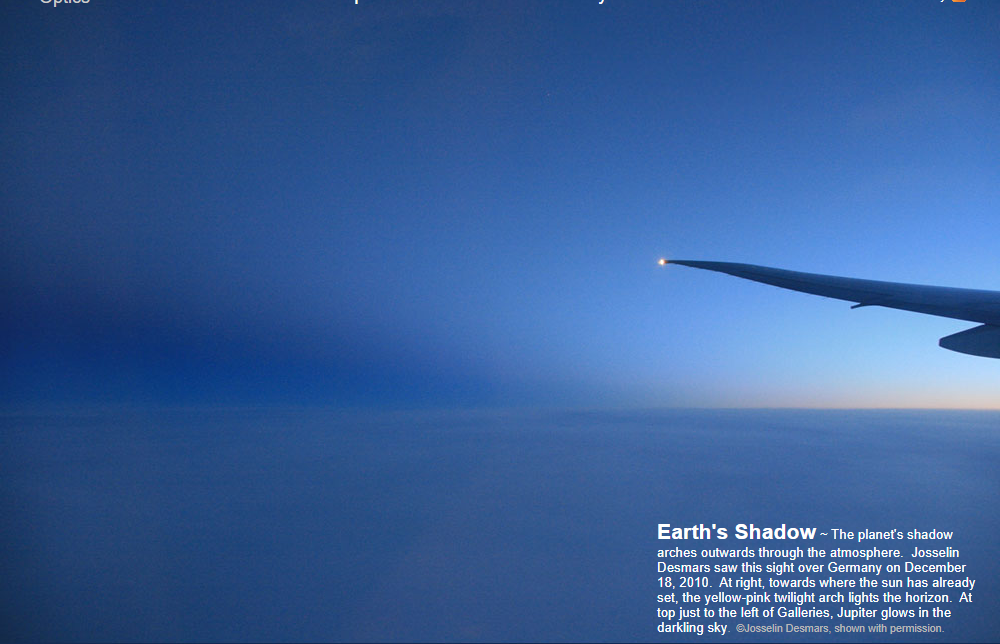OPOD - Earth's Shadow
OPOD - Earth's Shadow: A Phenomenon of the Atmosphere
Have you ever witnessed the mesmerizing sight of Earth's shadow stretching across the sky at sunset or sunrise? This captivating atmospheric phenomenon, known as Earth's Shadow, is a breathtaking display of nature's wonders. In this article, we will delve deeper into the intricacies of Earth's Shadow, exploring its formation, characteristics, and the science behind its awe-inspiring appearance.
What is Earth's Shadow?
Earth's Shadow is a striking phenomenon that occurs when the Earth casts its shadow into the atmosphere during twilight. As the sun sets or rises, the curvature of our planet projects a dark, bluish-gray shadow that extends upward into the sky. This shadow, often seen as a band or arch, gradually transitions from a deep blue hue near the horizon to a lighter shade at higher altitudes.
The Formation of Earth's Shadow
The formation of Earth's Shadow is a result of the scattering and absorption of sunlight by the Earth's atmosphere. During twilight, when the sun is below the horizon but still illuminating the atmosphere, the scattered sunlight interacts with the molecules and particles in the air. This scattering process causes shorter wavelengths (blue and violet) to scatter more easily, giving rise to the blue color observed in Earth's Shadow.
Characteristics of Earth's Shadow
Earth's Shadow possesses several distinctive characteristics that make it a fascinating spectacle to behold. Here are some key features:
-
Color Gradient: Earth's Shadow exhibits a beautiful gradient of colors, ranging from deep blues and purples near the horizon to lighter shades as it ascends higher into the sky. This gradient results from variations in the density and composition of atmospheric particles along the shadow's path.
-
Contrast with Twilight: When Earth's Shadow appears during twilight, it often contrasts with the warm hues of the twilight arch. The combination of the pink, orange, or yellow twilight colors alongside the blue-gray shadow creates a stunning visual contrast that captivates observers.
-
Shape and Extent: Earth's Shadow typically takes the form of a band or arch that stretches across the sky. The width and extent of the shadow depend on factors such as atmospheric conditions, the observer's location, and the altitude of the sun below the horizon.
The Science Behind Earth's Shadow
Understanding the science behind Earth's Shadow requires knowledge of atmospheric optics. When sunlight enters the Earth's atmosphere, it undergoes various interactions, including scattering, absorption, and reflection. These interactions with air molecules, aerosols, and other particles contribute to the formation of Earth's Shadow.
-
Rayleigh Scattering: Rayleigh scattering is a phenomenon where shorter wavelengths of light scatter more efficiently than longer wavelengths. This scattering effect is responsible for the blue color observed in Earth's Shadow. As sunlight passes through the atmosphere, the blue and violet wavelengths scatter more widely, resulting in the predominant blue hue.
-
Absorption and Diffusion: Along with scattering, absorption and diffusion of sunlight by atmospheric particles play a role in shaping Earth's Shadow. The composition and concentration of particles, such as dust, water droplets, and pollutants, influence the extent and appearance of the shadow.
-
Altitude and Perspective: The altitude of the observer and the angle at which sunlight enters the atmosphere also impact the appearance of Earth's Shadow. Higher altitudes may offer a wider view of the shadow's extent, while lower altitudes can provide a more pronounced color gradient.
Capturing Earth's Shadow
Photographing Earth's Shadow can yield stunning results, allowing you to preserve this fleeting natural wonder. Here are some tips to help you capture the beauty of Earth's Shadow:
-
Timing: Plan your photography session around sunrise or sunset when Earth's Shadow is most visible. The precise timing may vary depending on your location and the time of year.
-
Composition: Consider incorporating elements of the landscape or other objects to add depth and context to your photographs. This can enhance the visual impact of Earth's Shadow.
-
Exposure: Experiment with different exposure settings to capture the nuances of color and contrast within Earth's Shadow. Bracketing exposures can help you find the optimal settings for your specific conditions.
-
Post-Processing: After capturing your images, post-processing techniques can further enhance the colors and details of Earth's Shadow. Adjustments to contrast, saturation, and white balance can help bring out the true beauty of this atmospheric phenomenon.
Conclusion
Earth's Shadow is a mesmerizing display of nature's artistry that graces our skies during twilight. Understanding the science behind its formation and capturing its ethereal beauty through photography allows us to appreciate the wonders of our atmosphere. So, next time you find yourself witnessing Earth's Shadow, take a moment to marvel at the celestial spectacle unfolding before your eyes.

Earth's Shadow ~ The planet's shadow arches outwards through the atmosphere. Josselin Desmars saw this sight over Germany on December 18, 2010. At right, towards where the sun has already set, the yellow-pink twilight arch lights the horizon. At top just to the left of Galleries, Jupiter glows in the darkling sky. ©Josselin Desmars, shown with permission.
Note: this article has been automatically converted from the old site and may not appear as intended. You can find the original article here.
Reference Atmospheric Optics
If you use any of the definitions, information, or data presented on Atmospheric Optics, please copy the link or reference below to properly credit us as the reference source. Thank you!
-
<a href="https://atoptics.co.uk/blog/opod-earths-shadow/">OPOD - Earth's Shadow</a>
-
"OPOD - Earth's Shadow". Atmospheric Optics. Accessed on December 22, 2024. https://atoptics.co.uk/blog/opod-earths-shadow/.
-
"OPOD - Earth's Shadow". Atmospheric Optics, https://atoptics.co.uk/blog/opod-earths-shadow/. Accessed 22 December, 2024
-
OPOD - Earth's Shadow. Atmospheric Optics. Retrieved from https://atoptics.co.uk/blog/opod-earths-shadow/.